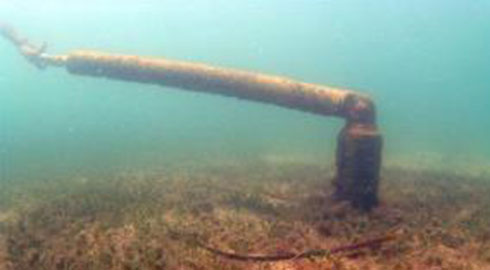
Traditional swing (also called block and chain) mooring designs use a heavy weight (usually a concrete block) on the seabed linked to a heavy chain, ropes and float to hold vessels in position under a range of weather conditions.
.jpg)
Block and chain mooring
As the boat swings with wind and currents it causes the chain to scour the seabed and seagrass, leaving a roughly circular bare patch around the mooring block. If the block is even slightly re-positioned when servicing, or is moved under extreme weather conditions, the mooring causes further damage to the seagrass bed and seafloor. Wave action on these scour patches can cause the sediment to further erode and destabilise the remaining seagrass bed.
While seagrass species such as eelgrass (Zostera spp.) and paddleweed (Halophila spp.) generally recover well after mooring disturbance is removed, other species such as strapweed (Posidonia australis), are very slow to grow and may take a long time to regenerate (Demers et al., 2013). Due to the impact of human activities on this species, P. australis is now listed as having six endangered populations in NSW at Port Hacking, Botany Bay, Sydney Harbour, Pittwater, Brisbane Waters and Lake Macquarie.
The mowing action caused by swing moorings in seagrass beds can cause extensive damage to valuable fish nursery habitat. At locations where there are numerous moorings, holes are formed in once continuous seagrass beds, forming a “swiss cheese” effect. You can see scarring in seagrass from aerial photos.
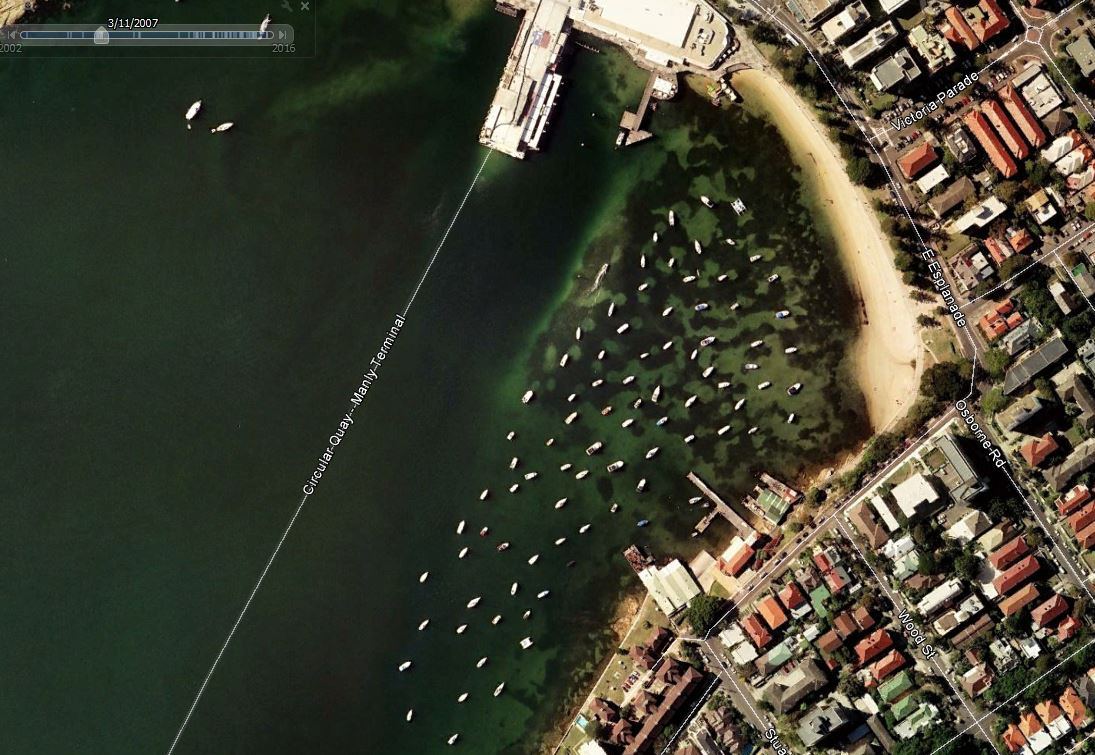
Google Earth imagery showing the extent of mooring scars in seagrass at Manly Cove East increasing from 2007 (left) and 2016 (right)
A recent study by NSW DPI estimated that 114,875 square metres of seagrass has been lost in Lake Macquarie alone from scouring by mooring chains (Glasby and West 2015).
Mooring damage to sensitive habitats impacts on fish habitat availability and quality, effectively reducing opportunities for fish to settle and grow as juveniles and adults. This costs the recreational and commercial fishing industries and the broader community as a result.
In NSW the NSW Department of Primary Industries (Fisheries) has responsibility for protecting seagrass habitat and requires a minimum 2:1 (area) compensation for activities that cause seagrass loss, which they value at $112 per square metre. This means that damage to seagrass caused by the average mooring scour in the Hunter region was likely to be worth $18,368 (Glasby and West 2015).
The solution
Environmentally friendly moorings (EFMs) have been installed around Australia and the world to protect sensitive habitats such as seagrass without compromising the safety or reliability of mooring a vessel. Since 2008, over 100 public and private moorings in NSW have been upgraded to EFMs, and over 230 are now installed in Moreton Bay, South-East Queensland.
There are several different designs available on the market, all of which raise the moving parts of the mooring above the seafloor to prevent chain drag and scouring of the seabed. The two main types installed in NSW and Qld are the Seagrass Friendly Mooring and Eco-mooring, with two other designs also available in Australia: Ezyrider and Seaflex, however they have not been extensively used in NSW.
A pull test conducted by Hunter Local Land Services compared the load bearing capabilities of both the Seagrass Friendly Mooring and the Eco-mooring against a 1 tonne block and chain mooring on both sand and mud substrates.
Seagrass Friendly Mooring and Eco-mooring pull test, Lake Macquarie NSW
The results indicated that the Seagrass Friendly Mooring had the greatest load bearing abilities, with both environmentally friendly designs being superior to the block and chain mooring under simulated extreme conditions.
|
|
Sand substrate |
Mud substrate |
||||
|
Mooring Type |
Peak Load (tonnes) |
Breakout? |
Rapid Pull (yes/no) |
Peak Load (tonnes) |
Breakout? |
Rapid Pull (yes/no) |
|
Swing |
0.7 |
Yes |
No |
1.08 |
Yes |
No |
|
Eco-Mooring |
1.67 |
No |
Yes |
1.49 |
Yes |
No |
|
Seagrass Friendly |
1.81 |
No |
Yes |
1.94 |
No |
Yes |
Seagrass Friendly Mooring design
The "Superhold" anchor is a 3.8 meter long, 115mm diameter heavy wall steel screw pile with a 280mm single flight helix at the base. This design therefore requires 3.8 metres of sediment for the mooring post to be screwed into the seabed as the anchor point. Attached to the mooring post just below the seabed is a set of load spreaders to stabilise the post.
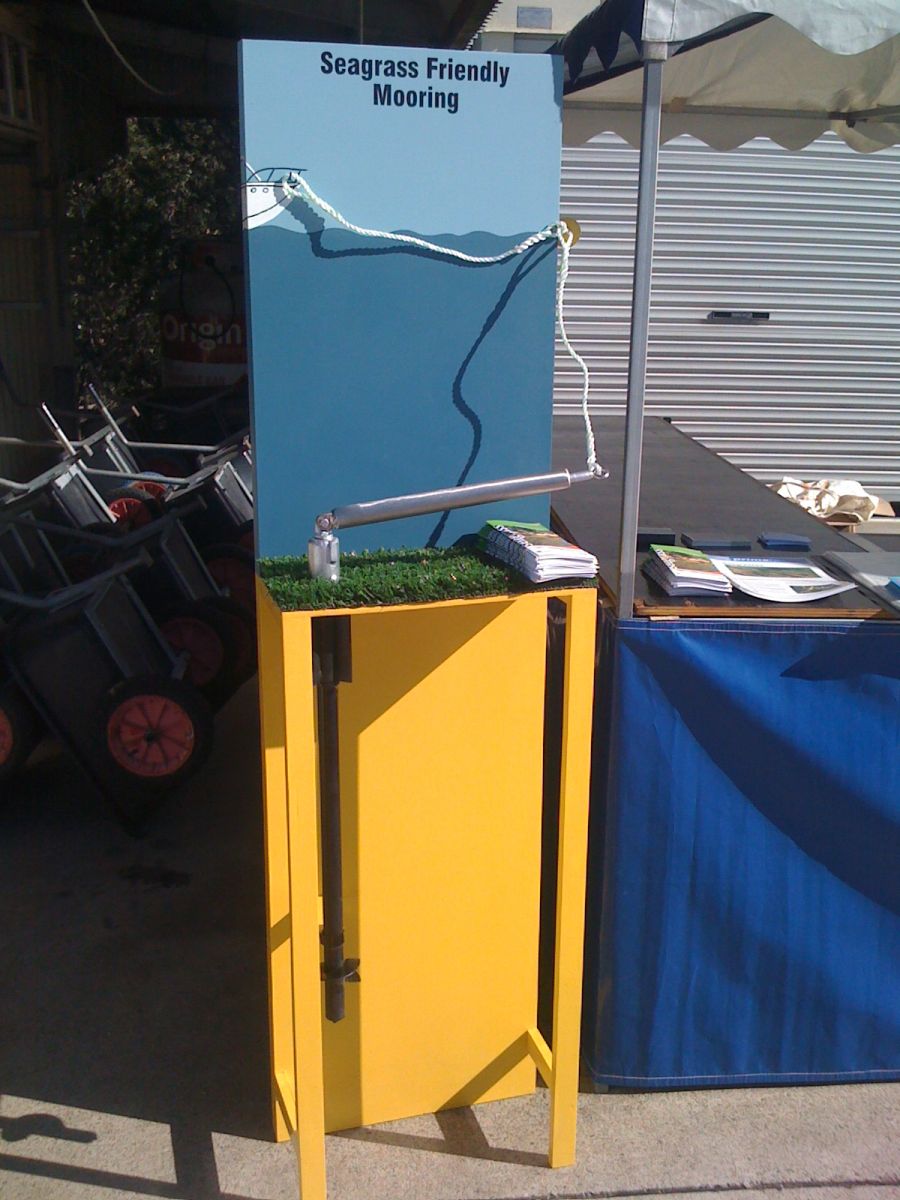
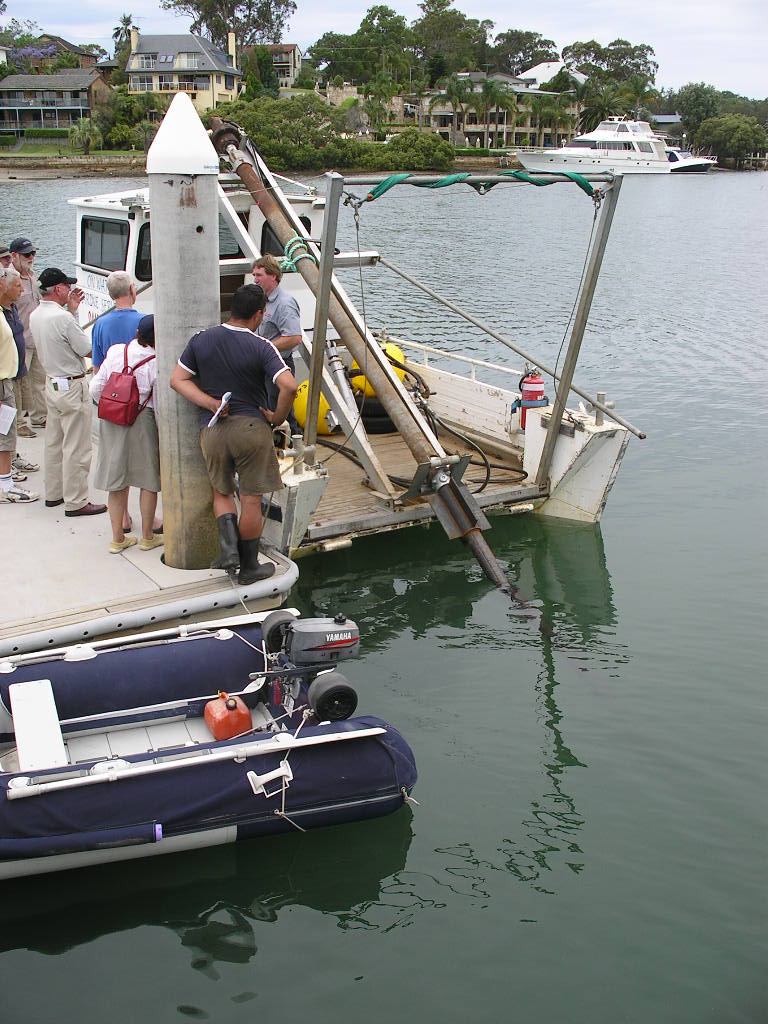
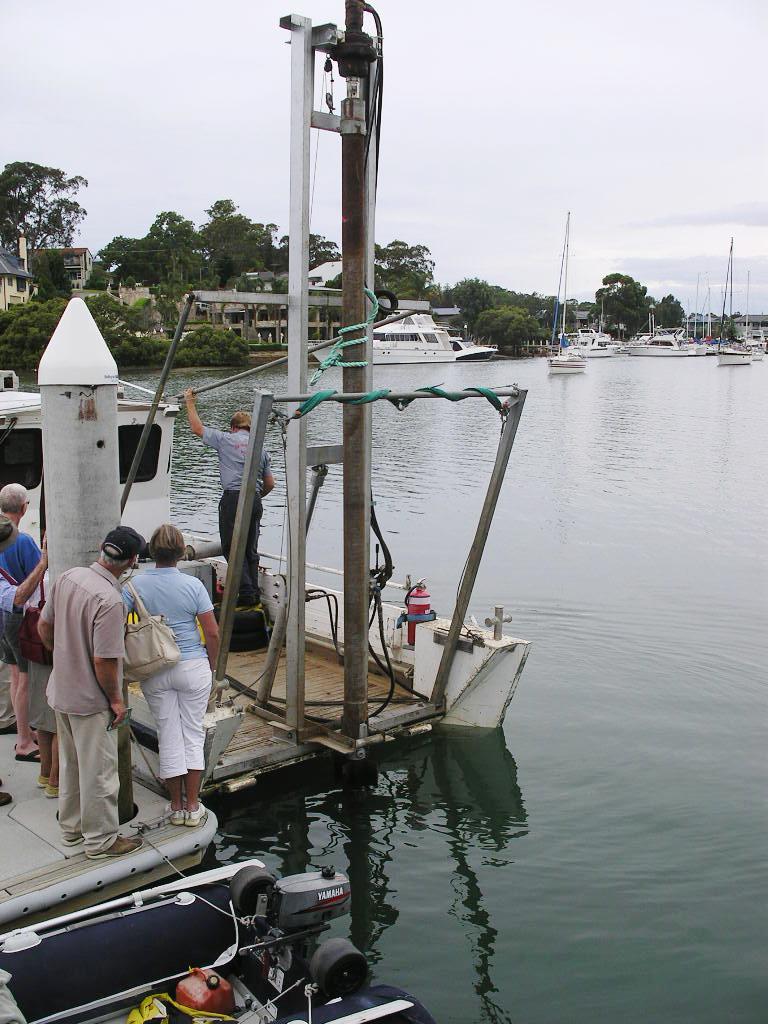
Model of Seagrass Friendly Mooring and installation demonstration, Bayview NSW
Two setup options are available for the “superhold” – one being where a UV stabilised marine grade riser is attached from the top of the anchorage at seabed level, to the shock absorber which is located inside a specially designed surface buoy. A "hawser" or pick up line is then connected to the other end of the shock absorber. The second is where the shock absorber is connected to the anchor point, with the riser linking this to the float and hawser.
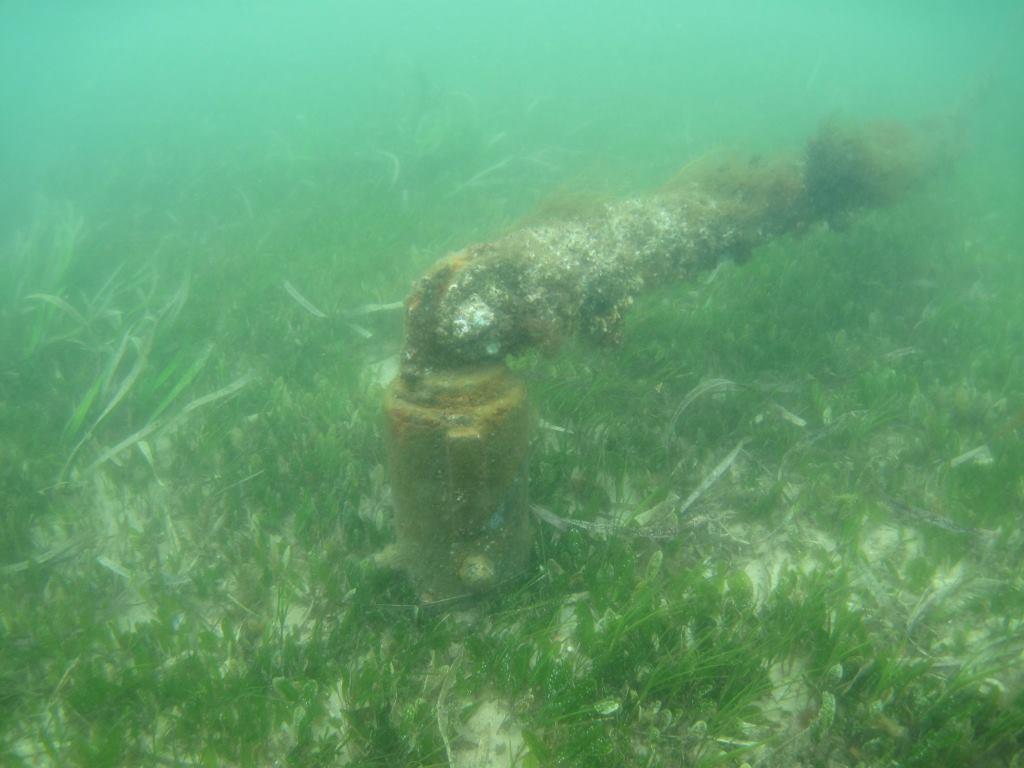
Seagrass Friendly Mooring with shock absorber attached to anchor point, Shoal Bay NSW (image courtesy Newcastle Innovation)
The Seagrass Friendly Mooring is installed and maintained from a boat fitted with a hydraulic auger drive. Photos of the system (including installation) can be found here.
The engineered rating for the Seagrass Friendly Mooring is 15 years for the mooring shaft which is the key component; the shock absorber needs to be serviced annually. Engineering certification has given a safe working load (SWL) rating equal to or greater than a 2.5 tonne dump weight mooring. The actual screw anchor has engineer certification from an in situ pull test to a SWL of 7 tonne.
An option to retrofit an existing mooring is also available and also employs the shock absorber in the float. The "Mooring in a Bag" system is designed to allow anyone to convert their existing chain mooring into an environmentally responsible apparatus able to safely and securely hold their vessel, reducing the impact on the seagrass beds around it.
The "Mooring in a Bag" system comes fully assembled with only a shackle join required to the first chain link on top of a suitable sized dump weight/sinker (Image courtesy On Water Marine Services)
Seagrass Friendly Moorings were installed in Moreton Bay prior to Tropical Cyclone Oswald and no failures were experienced due to storm weather although fouling from other vessels that had broken or dragged their conventional moorings did occur. See the case study on the Hunter LLS – Environmentally Friendly Moorings webpage for more information.
Eco-mooring design
The Eco-mooring consists of a helix anchor and Eco-mooring rode. Other required components are readily available mooring parts.
Eco-mooring system (image from their website)
The helix anchor is screwed into the seabed and is adaptable to almost any type of substratum e.g. sand, mud etc. The “rode” is the shock absorber of the mooring. It offers high flexibility by using an elastic core inside very strong rope. It allows the boat to move in surge and waves without causing continual shock on the anchor. These rodes have been bench tested to 33,000 lbs. The system allows for any buoy to be used on the surface.
The product website claims that a properly installed helix anchor can withstand the pulling force of an 800 hp tug boat and that many different test pulls, with strain gauges in the line, have registered in excess of 20,000 lbs of holding power. A pull test of this system can be viewed below.
Pull test of the Eco-mooring system
The helix anchor for the Eco-mooring has a ten- year warranty and the Eco-rode has a three-year warranty.
Ecomooring
A new design, similarly, but confusingly also called "Ecomooring" uses a mooring block that is shaped to create suction with the sediment. A chain then links the mooring block up to a large float that remains on the surface, even under load, preventing chain drag on the ocean floor. A rope then connects the float with a secondary, more upright, bouy that holds the rope out of the water, allowing easy connection to the boat for mooring.
Back to Fish Friendly Marine Infrastructure
| Organisation | NSW Department of Primary Industries (Fisheries) |
|---|---|
| Contact | Scott Nichols ph:(02) 6626 1396 e: [email protected] |
| Funding Body | NSW Environmental Trust |
References and Resources
Environmentally Friendly Mooring Manufacturers
Seagrass Friendly Moorings Eco-mooring systems
Seaflex Bouy mooring system Ezyrider mooring system
More information on seagrasses
Information on endangered populations of Posidonia australis in NSW
Information on saltmarsh, mangroves and seagrasses in NSW (scroll down to seagrasses)
Sensitive seagrass beds (Eco-mooring website)
More information about the issue and moorings
ABC News story on the impact of boat moorings in Sydney Harbour
Roads and Maritime Services website seagrasses with mentions of Environmentally Friendly Mooring investigations. Outlines the importance of seagrasses and what measures you can take to help preserve seagrass beds.
Hunter Local Land Services project subsidising installation of Environmentally Friendly Moorings in Lake Macquarie – need to be installed by June 2017. Site includes pull test video and information on Seagrass Friendly Mooring and Eco-mooring.
Hawkesbury Nepean Catchment Management Authority (now Greater Sydney Local Land Services) Seagrass Friendly Mooring video
Seaflex video of the mooring issue and Seaflex system
Photos of the Seagrass Friendly Mooring system (including installation in Moreton Bay, Qld)
Photo of Seagrass Friendly Mooring with shock absorber near seafloor
Blurb at SIMS website about monitoring of Seagrass Friendly Moorings in Manly and Pittwater
Seagrass Friendly Mooring and Eco-mooring pull test Lake Macquarie 2014
Eco-Mooring product website with underwater photos video and pull test video
Video of Towra Point traditional mooring ?
Roads and Maritime Services Private mooring licence conditions